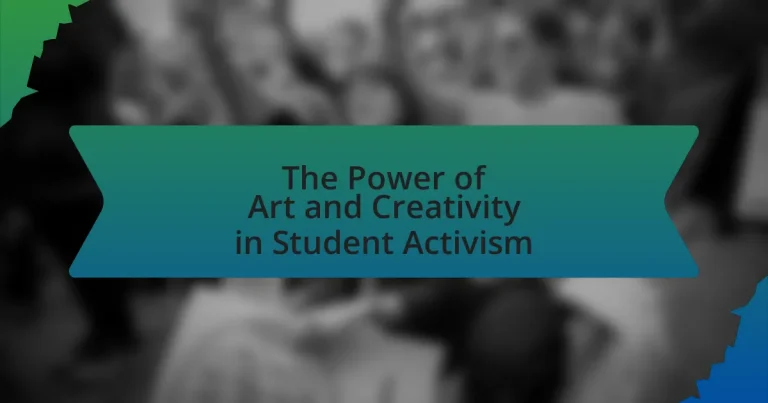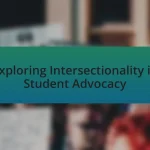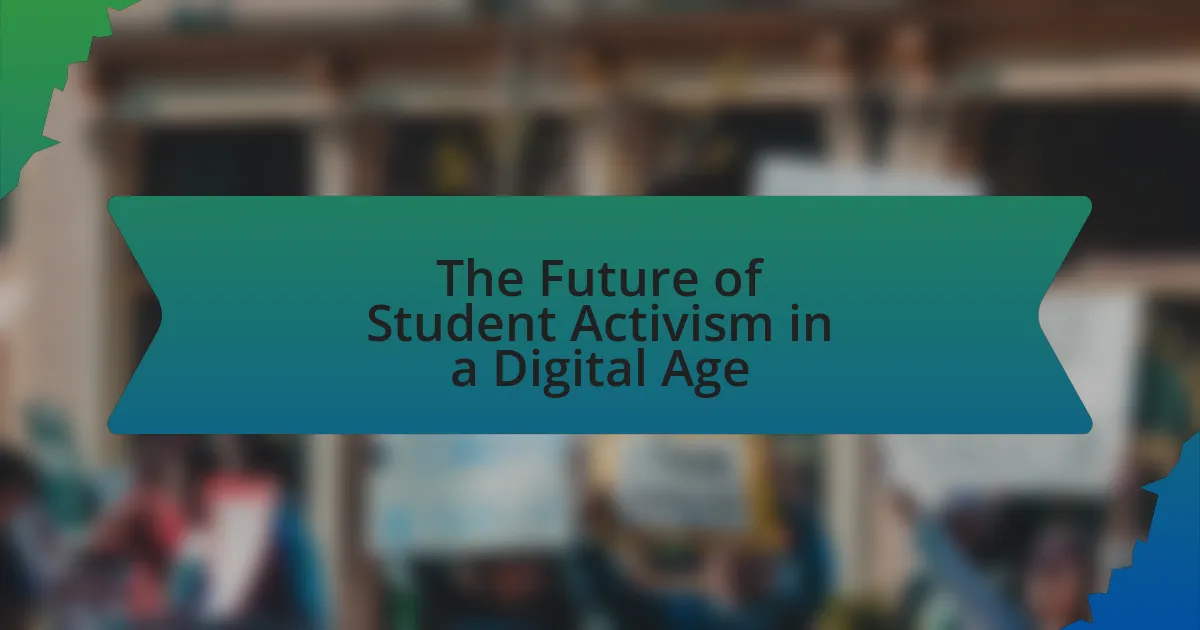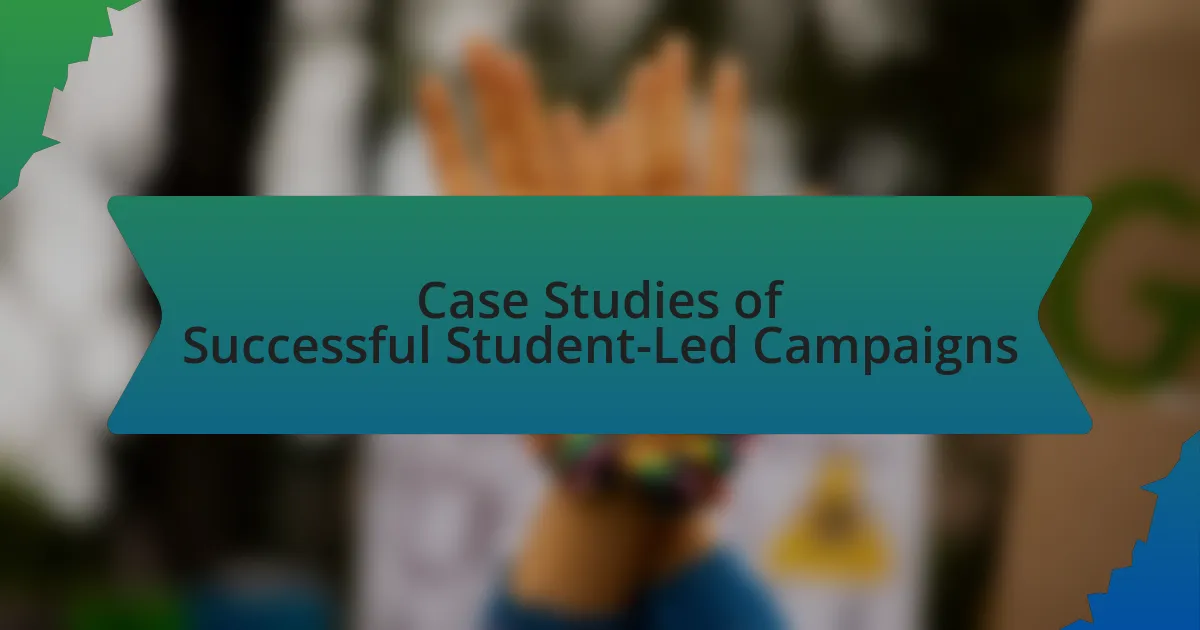The article explores the significant role of art and creativity in student activism, highlighting how these elements serve as essential tools for expression, mobilization, and raising awareness about social issues. It examines various forms of artistic expression, including visual art, music, theater, and digital media, and their impact on fostering community, enhancing emotional engagement, and driving participation in social movements. Additionally, the article addresses the challenges student activists face, such as censorship and funding limitations, while providing best practices for integrating art into activism and resources available to support artistic initiatives. Through historical examples and contemporary practices, the article underscores the transformative power of art in shaping student activism and influencing public perception.
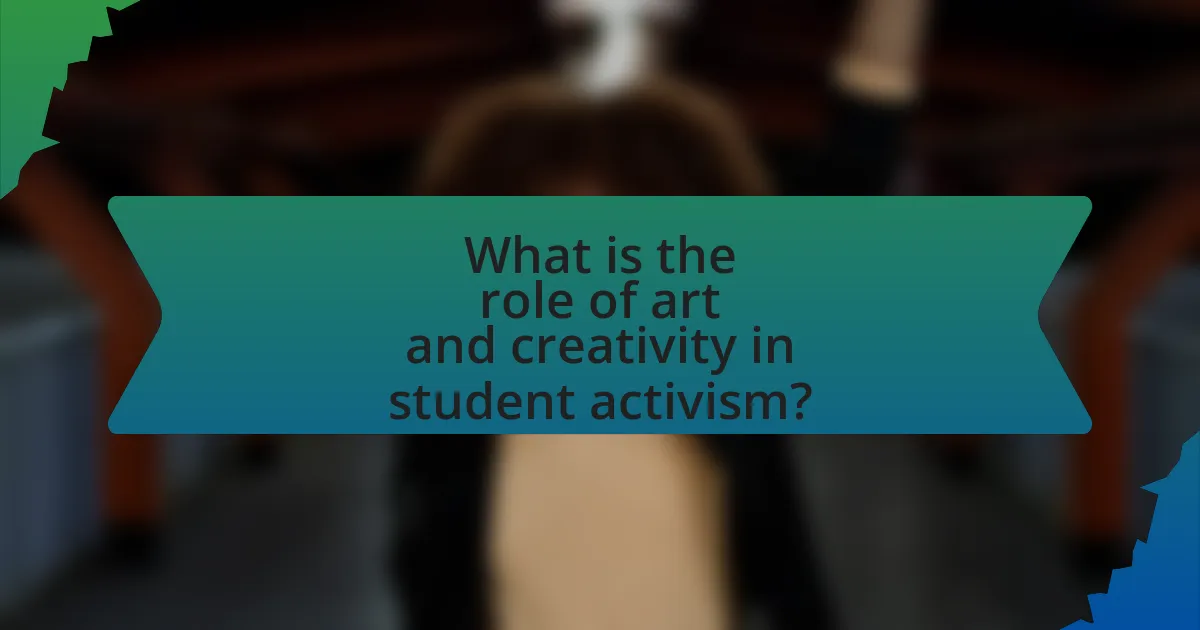
What is the role of art and creativity in student activism?
Art and creativity play a crucial role in student activism by serving as powerful tools for expression, mobilization, and awareness-raising. Through various forms of artistic expression, such as visual art, music, and performance, students can communicate their messages effectively and resonate emotionally with a broader audience. For instance, the use of murals and street art has historically been a means for students to visually articulate their demands and highlight social issues, as seen in movements like the Civil Rights Movement in the United States. Additionally, creative campaigns can engage and inspire peers, fostering a sense of community and collective action. Research indicates that art-based activism can enhance participation rates and deepen the impact of social movements, demonstrating its effectiveness in driving change.
How does art serve as a medium for student expression?
Art serves as a medium for student expression by providing a platform for individuals to convey their thoughts, emotions, and perspectives creatively. Through various forms such as painting, music, theater, and digital media, students can articulate their experiences and viewpoints on social issues, fostering a sense of identity and community. Research indicates that engaging in artistic activities enhances emotional intelligence and critical thinking, which are essential for effective communication and activism. For instance, a study published in the Journal of Educational Psychology found that students who participated in art programs demonstrated increased self-esteem and a greater ability to express complex ideas, validating the role of art as a powerful tool for personal and collective expression in student activism.
What forms of art are commonly used in student activism?
Visual art, music, theater, and literature are commonly used forms of art in student activism. Visual art includes posters, murals, and graffiti that convey messages and raise awareness about social issues. Music often serves as a rallying cry, with songs that inspire and unify participants during protests. Theater is utilized to dramatize social injustices, engaging audiences emotionally and intellectually. Literature, including poetry and essays, articulates the experiences and demands of activists, fostering dialogue and reflection. These forms of art have historically played significant roles in movements, such as the civil rights movement, where songs like “We Shall Overcome” became anthems of resistance.
How does creativity enhance the message of student movements?
Creativity enhances the message of student movements by making their messages more engaging and relatable. Creative expressions, such as art, music, and performance, capture attention and evoke emotional responses, which can lead to greater public support and awareness. For instance, the use of murals and street art during the 2011 Occupy Wall Street movement effectively communicated complex social issues in a visually impactful way, reaching a broader audience. Additionally, creative campaigns often utilize social media platforms to spread their messages virally, as seen in the #BlackLivesMatter movement, where artistic content amplified calls for justice and equality. This combination of emotional resonance and widespread reach demonstrates how creativity is a powerful tool in enhancing the effectiveness of student activism.
Why is creativity important in mobilizing student activism?
Creativity is important in mobilizing student activism because it fosters innovative approaches to communication and engagement. Creative methods, such as art, music, and performance, capture attention and resonate emotionally, making messages more impactful. For instance, the use of visual art in protests has historically drawn significant media coverage and public interest, as seen in the 2011 Occupy Wall Street movement, where art installations amplified the movement’s message. This emotional connection encourages participation and solidarity among students, ultimately leading to more effective activism.
How does creative expression foster community among students?
Creative expression fosters community among students by providing a shared platform for collaboration and communication. When students engage in artistic activities, such as theater, music, or visual arts, they often work together towards common goals, which enhances their sense of belonging. Research indicates that participation in creative projects can lead to increased social cohesion; for instance, a study published in the Journal of Educational Psychology found that students involved in collaborative art projects reported stronger connections with their peers and a greater sense of community. This collaborative environment encourages empathy, understanding, and support among students, further solidifying their communal ties.
What psychological effects does art have on student activists?
Art has significant psychological effects on student activists, primarily enhancing their emotional expression and fostering a sense of community. Engaging with art allows student activists to articulate their feelings about social issues, which can lead to increased emotional resilience and coping mechanisms. Research indicates that creative expression can reduce stress and anxiety, promoting mental well-being among individuals involved in activism. For instance, a study published in the Journal of Community Psychology found that participants who engaged in artistic activities reported higher levels of empowerment and lower levels of psychological distress. This demonstrates that art not only serves as a tool for communication but also plays a crucial role in supporting the mental health of student activists.
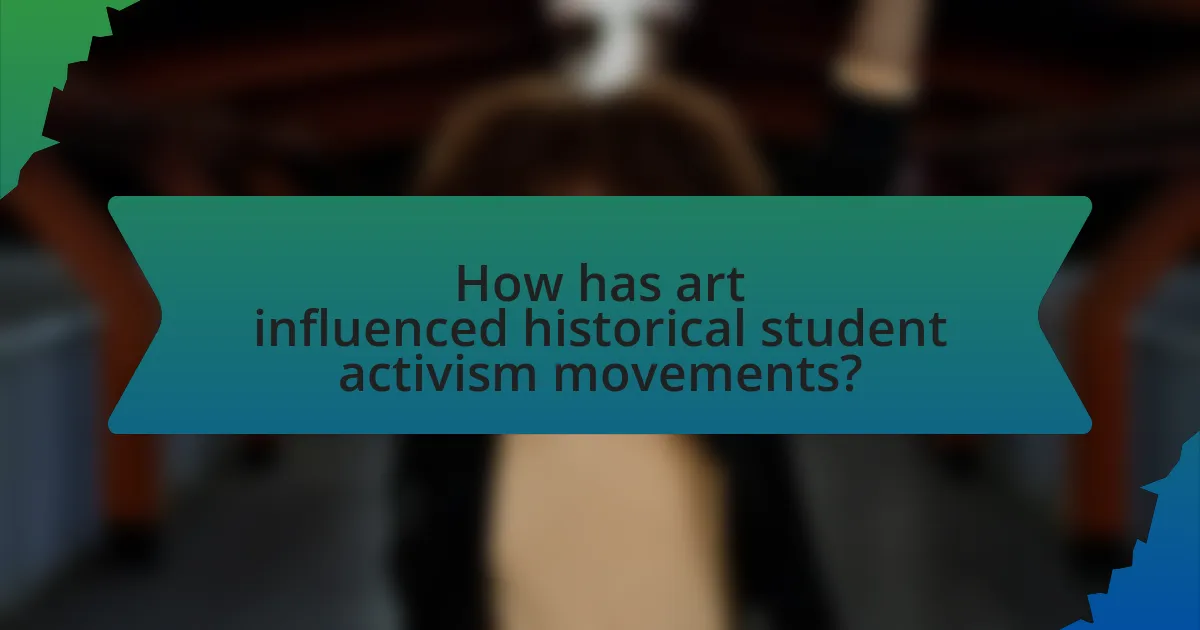
How has art influenced historical student activism movements?
Art has significantly influenced historical student activism movements by serving as a powerful tool for expression and mobilization. For instance, during the 1960s, student protests against the Vietnam War utilized visual art, music, and performance to convey anti-war sentiments, exemplified by the iconic protest song “Fortunate Son” by Creedence Clearwater Revival, which resonated with the youth and galvanized public opinion. Additionally, the use of posters and graffiti during the Civil Rights Movement, such as the artwork of Emory Douglas for the Black Panther Party, effectively communicated messages of resistance and solidarity, inspiring students to engage in activism. These artistic expressions not only captured the emotions and aspirations of the movements but also played a crucial role in uniting individuals around common causes, demonstrating the profound impact of art on student activism throughout history.
What are some notable examples of art in past student protests?
Notable examples of art in past student protests include the use of murals during the 1968 student protests in Paris, which expressed revolutionary sentiments and solidarity. Additionally, the “We Are the 99%” campaign during the Occupy Wall Street movement featured art in the form of posters and graffiti that highlighted economic inequality and social justice issues. In the 2014 Hong Kong Umbrella Movement, students created large-scale art installations and banners that symbolized their demands for democracy and freedom. These artistic expressions served as powerful tools for communication and mobilization, reinforcing the messages of the protests and engaging broader audiences.
How did these artistic expressions impact public perception?
Artistic expressions significantly shaped public perception by conveying powerful messages that resonate emotionally with audiences. For instance, student-led art initiatives during protests often highlight social injustices, making complex issues more relatable and understandable. This emotional engagement can lead to increased awareness and support for causes, as seen in movements like the 2018 March for Our Lives, where student-created artwork effectively communicated the urgency of gun control, influencing public opinion and policy discussions. Such artistic endeavors not only amplify voices but also foster community solidarity, ultimately altering how society views critical issues.
What lessons can current activists learn from these historical examples?
Current activists can learn the importance of using art and creativity as powerful tools for communication and mobilization from historical examples of student activism. Historical movements, such as the 1960s anti-war protests and the Civil Rights Movement, effectively utilized music, visual art, and performance to convey messages, inspire solidarity, and attract media attention. For instance, the song “We Shall Overcome” became an anthem for the Civil Rights Movement, uniting diverse groups and fostering a sense of shared purpose. This demonstrates that creative expressions can transcend barriers and resonate emotionally, making complex issues more accessible and engaging to a broader audience. By incorporating artistic elements into their activism, current activists can enhance their outreach and impact, drawing on the proven effectiveness of these historical precedents.
In what ways has technology changed the landscape of art in student activism?
Technology has transformed the landscape of art in student activism by enabling widespread dissemination and engagement through digital platforms. Social media allows students to share their artistic expressions, such as murals, videos, and graphic designs, reaching global audiences instantly. For instance, the viral spread of art related to movements like Black Lives Matter showcases how digital tools amplify student voices and messages. Additionally, technology facilitates collaboration among students across different locations, fostering a collective creative process that enhances the impact of their activism. The use of digital art tools and software has also democratized art creation, allowing more students to participate in activism through visual storytelling.
How do social media platforms amplify artistic activism?
Social media platforms amplify artistic activism by providing a global stage for artists to share their work and messages instantly. These platforms enable artists to reach diverse audiences, facilitating the rapid dissemination of art that addresses social issues, such as climate change or racial injustice. For instance, the viral spread of the “Black Lives Matter” mural in 2020 showcased how social media can elevate artistic expressions that resonate with activism, leading to increased awareness and engagement. Additionally, platforms like Instagram and TikTok allow for interactive engagement, where users can participate in challenges or share their interpretations, further enhancing the impact of artistic activism.
What role do digital art forms play in modern student movements?
Digital art forms play a crucial role in modern student movements by facilitating communication, expression, and mobilization. These art forms, including graphic design, social media visuals, and digital storytelling, enable students to convey their messages effectively and engage a wider audience. For instance, during the 2019 climate strikes, students utilized digital art to create compelling visuals that spread awareness and garnered global support, demonstrating the power of visual communication in activism. Furthermore, platforms like Instagram and TikTok have become essential tools for students to share their artistic expressions, rally support, and organize events, thereby amplifying their voices in social and political discourse.
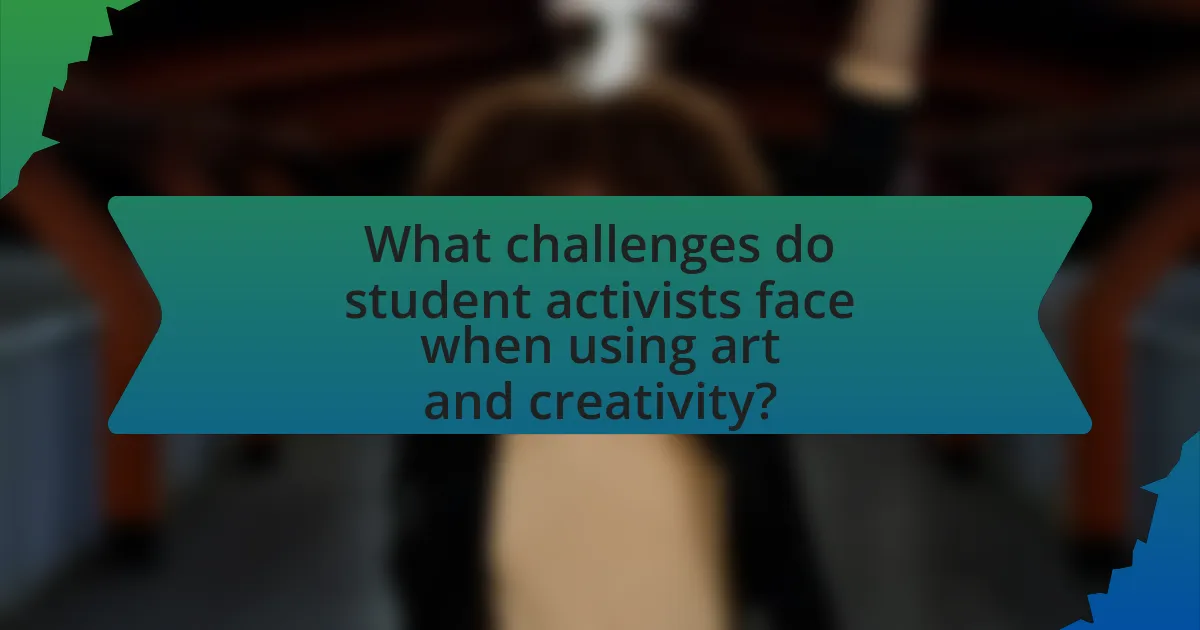
What challenges do student activists face when using art and creativity?
Student activists face several challenges when using art and creativity, including censorship, funding limitations, and the risk of misinterpretation. Censorship can occur when authorities restrict artistic expression that critiques social or political issues, limiting the effectiveness of the message. Funding limitations often hinder the ability to produce high-quality art, as many student activists rely on limited resources for materials and venues. Additionally, the risk of misinterpretation arises when audiences may not fully grasp the intended message of the artwork, leading to confusion or backlash against the activists. These challenges can significantly impact the overall effectiveness of art as a tool for activism.
How can censorship affect artistic expression in activism?
Censorship can significantly restrict artistic expression in activism by limiting the themes and messages that artists can convey. When authorities impose censorship, they often target works that challenge the status quo or provoke critical thought, thereby stifling dissent and reducing the diversity of perspectives in public discourse. For instance, during the Tiananmen Square protests in 1989, the Chinese government censored art that depicted the movement, which hindered the ability of artists to communicate their experiences and messages effectively. This suppression not only affects individual artists but also diminishes the overall impact of activism, as art plays a crucial role in mobilizing communities and fostering social change.
What strategies can students employ to overcome censorship?
Students can employ various strategies to overcome censorship, including utilizing digital platforms, engaging in creative expression, and forming coalitions. Digital platforms, such as social media and blogs, allow students to share uncensored information and perspectives widely, bypassing traditional media restrictions. Creative expression through art, music, and literature serves as a powerful tool for conveying messages that challenge censorship, as these mediums can evoke emotional responses and provoke thought without directly confronting authorities. Additionally, forming coalitions with like-minded individuals and organizations amplifies their voices, providing a united front against censorship efforts. Historical examples, such as the use of graffiti during political protests, demonstrate how creativity can effectively challenge oppressive narratives and promote free expression.
How do funding issues impact artistic projects in student activism?
Funding issues significantly hinder artistic projects in student activism by limiting resources necessary for execution. When financial support is inadequate, students face challenges in acquiring materials, venues, and promotional efforts essential for their projects. For instance, a study by the National Endowment for the Arts found that 70% of arts organizations reported funding constraints as a primary barrier to project development. This lack of funding can lead to reduced visibility and impact of artistic expressions, ultimately diminishing the effectiveness of activism efforts aimed at social change.
What are the best practices for integrating art into student activism?
The best practices for integrating art into student activism include fostering collaboration between artists and activists, utilizing diverse art forms to convey messages, and creating inclusive spaces for expression. Collaboration enhances the impact of activism by combining artistic skills with activist goals, as seen in initiatives like the “Artivism” movement, which merges art and activism to address social issues. Diverse art forms, such as murals, performances, and digital media, can reach broader audiences and resonate emotionally, exemplified by the use of street art in protests to communicate urgent messages. Additionally, inclusive spaces encourage participation from various community members, ensuring that multiple perspectives are represented, which strengthens the overall message and effectiveness of the activism.
How can students collaborate effectively on artistic projects?
Students can collaborate effectively on artistic projects by establishing clear communication, defining roles, and utilizing collaborative tools. Clear communication ensures that all members understand the project goals and can share ideas openly, which is essential for creativity. Defining roles allows each student to contribute their strengths, whether in design, execution, or critique, fostering a sense of ownership and accountability. Utilizing collaborative tools, such as shared digital platforms for brainstorming and project management, enhances coordination and keeps everyone aligned. Research indicates that collaborative learning environments improve creativity and problem-solving skills, as seen in studies by Johnson and Johnson, which highlight the benefits of teamwork in educational settings.
What resources are available for students to enhance their artistic activism?
Students can enhance their artistic activism through various resources such as workshops, online platforms, and community organizations. Workshops offered by institutions like the Art for Social Change program provide hands-on experience in using art for advocacy. Online platforms like Instagram and TikTok allow students to share their artistic messages widely, reaching diverse audiences. Community organizations, such as the Youth Arts Collective, offer mentorship and funding opportunities for projects that focus on social issues. These resources empower students to effectively express their activism through art, fostering engagement and awareness in their communities.
